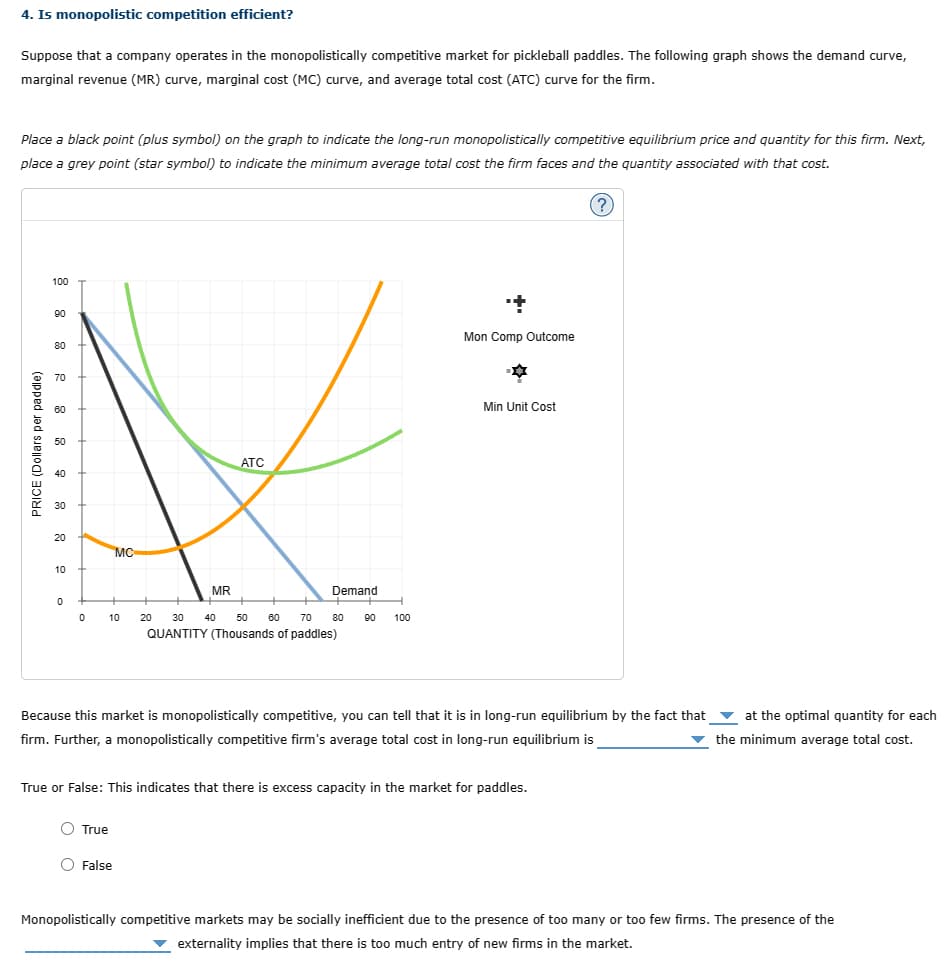4. Is monopolistic competition efficient? Suppose that a company operates in the monopolistically competitive market for pickleball paddles. The following graph shows the demand curve, marginal revenue (MR) curve, marginal cost (MC) curve, and average total cost (ATC) curve for the firm. Place a black point (plus symbol) on the graph to indicate the long-run monopolistically competitive equilibrium price and quantity for this firm. Next, place a grey point (star symbol) to indicate the minimum average total cost the firm faces and the quantity associated with that cost. ? PRICE (Dollars per paddle) 100 90 80 70 60 40 30 20 MC 10 ATC MR Demand 0 0 10 20 30 40 50 60 70 80 90 100 QUANTITY (Thousands of paddles) + Mon Comp Outcome ** Min Unit Cost Because this market is monopolistically competitive, you can tell that it is in long-run equilibrium by the fact that firm. Further, a monopolistically competitive firm's average total cost in long-run equilibrium is True or False: This indicates that there is excess capacity in the market for paddles. True False at the optimal quantity for each the minimum average total cost. Monopolistically competitive markets may be socially inefficient due to the presence of too many or too few firms. The presence of the externality implies that there is too much entry of new firms in the market.
4. Is monopolistic competition efficient? Suppose that a company operates in the monopolistically competitive market for pickleball paddles. The following graph shows the demand curve, marginal revenue (MR) curve, marginal cost (MC) curve, and average total cost (ATC) curve for the firm. Place a black point (plus symbol) on the graph to indicate the long-run monopolistically competitive equilibrium price and quantity for this firm. Next, place a grey point (star symbol) to indicate the minimum average total cost the firm faces and the quantity associated with that cost. ? PRICE (Dollars per paddle) 100 90 80 70 60 40 30 20 MC 10 ATC MR Demand 0 0 10 20 30 40 50 60 70 80 90 100 QUANTITY (Thousands of paddles) + Mon Comp Outcome ** Min Unit Cost Because this market is monopolistically competitive, you can tell that it is in long-run equilibrium by the fact that firm. Further, a monopolistically competitive firm's average total cost in long-run equilibrium is True or False: This indicates that there is excess capacity in the market for paddles. True False at the optimal quantity for each the minimum average total cost. Monopolistically competitive markets may be socially inefficient due to the presence of too many or too few firms. The presence of the externality implies that there is too much entry of new firms in the market.
Principles of Economics, 7th Edition (MindTap Course List)
7th Edition
ISBN:9781285165875
Author:N. Gregory Mankiw
Publisher:N. Gregory Mankiw
Chapter16: Monopolistic Competition
Section: Chapter Questions
Problem 5PA
Related questions
Question
i need your solution...

Transcribed Image Text:4. Is monopolistic competition efficient?
Suppose that a company operates in the monopolistically competitive market for pickleball paddles. The following graph shows the demand curve,
marginal revenue (MR) curve, marginal cost (MC) curve, and average total cost (ATC) curve for the firm.
Place a black point (plus symbol) on the graph to indicate the long-run monopolistically competitive equilibrium price and quantity for this firm. Next,
place a grey point (star symbol) to indicate the minimum average total cost the firm faces and the quantity associated with that cost.
?
PRICE (Dollars per paddle)
100
90
80
70
60
40
30
20
MC
10
ATC
MR
Demand
0
0 10
20
30
40
50
60
70
80
90 100
QUANTITY (Thousands of paddles)
+
Mon Comp Outcome
**
Min Unit Cost
Because this market is monopolistically competitive, you can tell that it is in long-run equilibrium by the fact that
firm. Further, a monopolistically competitive firm's average total cost in long-run equilibrium is
True or False: This indicates that there is excess capacity in the market for paddles.
True
False
at the optimal quantity for each
the minimum average total cost.
Monopolistically competitive markets may be socially inefficient due to the presence of too many or too few firms. The presence of the
externality implies that there is too much entry of new firms in the market.
AI-Generated Solution
Unlock instant AI solutions
Tap the button
to generate a solution
Recommended textbooks for you

Principles of Economics, 7th Edition (MindTap Cou…
Economics
ISBN:
9781285165875
Author:
N. Gregory Mankiw
Publisher:
Cengage Learning

Principles of Economics (MindTap Course List)
Economics
ISBN:
9781305585126
Author:
N. Gregory Mankiw
Publisher:
Cengage Learning

Principles of Microeconomics (MindTap Course List)
Economics
ISBN:
9781305971493
Author:
N. Gregory Mankiw
Publisher:
Cengage Learning

Principles of Economics, 7th Edition (MindTap Cou…
Economics
ISBN:
9781285165875
Author:
N. Gregory Mankiw
Publisher:
Cengage Learning

Principles of Economics (MindTap Course List)
Economics
ISBN:
9781305585126
Author:
N. Gregory Mankiw
Publisher:
Cengage Learning

Principles of Microeconomics (MindTap Course List)
Economics
ISBN:
9781305971493
Author:
N. Gregory Mankiw
Publisher:
Cengage Learning

Principles of Microeconomics
Economics
ISBN:
9781305156050
Author:
N. Gregory Mankiw
Publisher:
Cengage Learning

Principles of Economics 2e
Economics
ISBN:
9781947172364
Author:
Steven A. Greenlaw; David Shapiro
Publisher:
OpenStax
